| Good Friday |
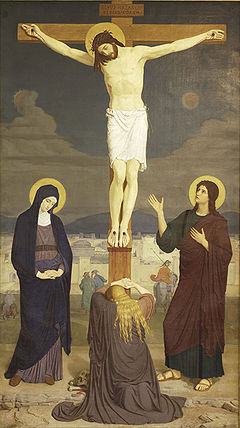 |
| A Stabat Mater depiction, 1868 |
|
Good Friday is a Christian holiday commemorating the crucifixion of Jesus and his death at
Calvary. It is observed during Holy Week as part of the Paschal Triduum on the Friday preceding
Easter Sunday, and may coincide with the Jewish observance of Passover. It is also known as
Holy
Friday,
Great Friday,
Great and Holy Friday (also
Holy and Great Friday),
and
Black Friday.
Members of many Christian denominations, including the Catholic, Eastern Orthodox, Lutheran,
Anglican, Methodist, Oriental Orthodox and Reformed traditions, observe Good Friday with fasting
and church services. Communicants of the Moravian Church have a Good Friday tradition of cleaning
gravestones in Moravian cemeteries.
The date of Good Friday varies from one year to the next on both the Gregorian and Julian
calendars. Eastern and Western Christianity disagree over the computation of the date of Easter and
therefore of Good Friday. Good Friday is a widely instituted legal holiday around the world,
including in most Western countries and 12 U.S. states. Some countries, such as Germany, have laws
prohibiting certain acts, such as dancing and horse racing, that are seen as profaning the solemn
nature of the day.
Name
Etymology
"Good Friday" comes from the obsolete sense "pious, holy" of the word "good". Less common examples
of expressions based on this obsolete sense of "good" include "the good book" for the Bible, "good
tide" for "Christmas" or Shrovetide, and Good Wednesday for the Wednesday in Holy Week.
A common folk etymology incorrectly analyzes "Good Friday" as a corruption of "God Friday" similar
to the linguistically correct description of "goodbye" as a contraction of "God be with you". In
Old English, the day was called "Long Friday" (
langa frigedæg) , and this term was adopted
from Old English and is still used in Scandinavian languages and Finnish.
Other languages
In Latin, the name used by the Catholic Church until 1955 was
Feria sexta in Parasceve
("Friday of Preparation [for the Sabbath]"). In the 1955 reform of Holy Week, it was renamed
Feria sexta in Passione et Morte Domini ("Friday of the Passion and Death of the Lord"), and
in the new rite introduced in 1970, shortened to
Feria sexta in Passione Domini ("Friday of
the Passion of the Lord").
In Dutch, Good Friday is known as
Goede Vrijdag, in Frisian as
Goedfreed. In German-
speaking countries, it is generally referred to as
Karfreitag ("Mourning Friday", with
Kar from Old High German kara‚ "bewail", "grieve"‚ "mourn", which is related to the English
word "care" in the sense of cares and woes), but it is sometimes also called
Stiller Freitag
("Silent Friday") and
Hoher Freitag ("High Friday, Holy Friday"). In the Scandinavian
languages and Finnish ("
pitkäperjantai"), it is called the equivalent of "Long Friday" as it
was in Old English ("
Langa frigedæg").
In Greek, Polish, Hungarian, and Romanian it is generally referred to as the equivalent of "Great
Friday" (
Wielki Piatek,
Nagypéntek,
Vinerea Mare). In French and Spanish it
is referred to as
Vendredi saint and
Viernes Santo ("Holy Friday").
Biblical accounts
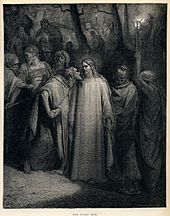 |
|
The Judas Kiss by Gustave Doré, 1866
|
According to the accounts in the Gospels, the royal soldiers, guided by Jesus' disciple Judas
Iscariot, arrested Jesus in the Garden of Gethsemane. Judas received money (30 pieces of silver)
(Matthew 26:14–16) for betraying Jesus and told the guards that whomever he kisses is the one they
are to arrest. Following his arrest, Jesus was taken to the house of Annas, the father-in-law of
the high priest, Caiaphas. There he was interrogated with little result and sent bound to Caiaphas
the high priest where the Sanhedrin had assembled (John 18:1–24).
Conflicting testimony against Jesus was brought forth by many witnesses, to which Jesus answered
nothing. Finally the high priest adjured Jesus to respond under solemn oath, saying "I adjure you,
by the Living God, to tell us, are you the Anointed One, the Son of God?" Jesus testified
ambiguously, "You have said it, and in time you will see the Son of Man seated at the right hand of
the Almighty, coming on the clouds of Heaven." The high priest condemned Jesus for blasphemy, and
the Sanhedrin concurred with a sentence of death (Matthew 26:57–66). Peter, waiting in the
courtyard, also denied Jesus three times to bystanders while the interrogations were proceeding
just as Jesus had predicted.
In the morning, the whole assembly brought Jesus to the Roman governor Pontius Pilate under
charges of subverting the nation, opposing taxes to Caesar, and making himself a king (Luke
23:1–2). Pilate authorized the Jewish leaders to judge Jesus according to their own law and execute
sentencing; however, the Jewish leaders replied that they were not allowed by the Romans to carry
out a sentence of death (John 18:31).
Pilate questioned Jesus and told the assembly that there was no basis for sentencing. Upon
learning that Jesus was from Galilee, Pilate referred the case to the ruler of Galilee, King Herod,
who was in Jerusalem for the Passover Feast. Herod questioned Jesus but received no answer; Herod
sent Jesus back to Pilate. Pilate told the assembly that neither he nor Herod found Jesus to be
guilty; Pilate resolved to have Jesus whipped and released (Luke 23:3–16). Under the guidance of
the chief priests, the crowd asked for Barabbas, who had been imprisoned for committing murder
during an insurrection. Pilate asked what they would have him do with Jesus, and they demanded,
"Crucify him" (Mark 15:6–14). Pilate's wife had seen Jesus in a dream earlier that day, and she
forewarned Pilate to "have nothing to do with this righteous man" (Matthew 27:19). Pilate had Jesus
flogged and then brought him out to the crowd to release him. The chief priests informed Pilate of
a new charge, demanding Jesus be sentenced to death "because he claimed to be God's son." This
possibility filled Pilate with fear, and he brought Jesus back inside the palace and demanded to
know from where he came (John 19:1–9).
.jpg) |
|
Antonio Ciseri's depiction of Ecce Homo with Jesus and Pontius Pilate, 19th century
|
Coming before the crowd one last time, Pilate declared Jesus innocent and washed his own hands in
water to show he had no part in this condemnation. Nevertheless, Pilate handed Jesus over to be
crucified in order to forestall a riot (Matthew 27:24–26) and ultimately to keep his job. The
sentence written was "Jesus of Nazareth, King of the Jews." Jesus carried his cross to the site of
execution (assisted by Simon of Cyrene), called the "place of the Skull", or "Golgotha" in Hebrew
and in Latin "Calvary". There he was crucified along with two criminals (John 19:17–22).
Jesus agonized on the cross for six hours. During his last three hours on the cross, from noon to
3 pm, darkness fell over the whole land. Jesus spoke from the cross, quoting the messianic Psalm
22: "
My God, my God, why have you forsaken me?"
With a loud cry, Jesus gave up his spirit. There was an earthquake, tombs broke open, and the
curtain in the Temple was torn from top to bottom. The centurion on guard at the site of
crucifixion declared, "Truly this was God's Son!" (Matthew 27:45–54)
Joseph of Arimathea, a member of the Sanhedrin and a secret follower of Jesus, who had not
consented to his condemnation, went to Pilate to request the body of Jesus (Luke 23:50–52). Another
secret follower of Jesus and member of the Sanhedrin named Nicodemus brought about a hundred-pound
weight mixture of spices and helped wrap the body of Jesus (John 19:39–40). Pilate asked
confirmation from the centurion of whether Jesus was dead (Mark 15:44). A soldier pierced the side
of Jesus with a lance causing blood and water to flow out (John 19:34), and the centurion informed
Pilate that Jesus was dead (Mark 15:45).
Joseph of Arimathea took Jesus' body, wrapped it in a clean linen shroud, and placed it in his own
new tomb that had been carved in the rock (Matthew 27:59–60) in a garden near the site of the
crucifixion. Nicodemus (John 3:1) also brought 75 pounds of myrrh and aloes, and placed them in the
linen with the body, in keeping with Jewish burial customs (John 19:39–40). They rolled a large
rock over the entrance of the tomb (Matthew 27:60). Then they returned home and rested, because
Shabbat had begun at sunset (Luke 23:54–56). Matt. 28:1 "After the Shabbat, at dawn on the first
day of the week, Mary Magdalene and the other Mary went to look at the tomb". i.e. "After the
Sabbath, at dawn on the first day of the week,...". "He is not here; he has risen, just as he
said....". (Matt. 28:6)
Eastern Apostolic Christianity
 |
|
Icon of the Crucifixion, 16th century, by Theophanes the Cretan (Stavronikita Monastery, Mount
Athos) |
Byzantine Christians (Eastern Christians who follow the Rite of Constantinople: Orthodox
Christians and Greek-Catholics) call this day "Great and Holy Friday", or simply "Great Friday".
Because the sacrifice of Jesus through his crucifixion is recalled on this day, the
Divine
Liturgy (the sacrifice of bread and wine) is never celebrated on Great Friday, except when this
day coincides with the Great Feast of the Annunciation, which falls on the fixed date of 25 March
(for those churches which follow the traditional Julian Calendar, 25 March currently falls on 7
April of the modern Gregorian Calendar). Also on Great Friday, the clergy no longer wear the purple
or red that is customary throughout Great Lent, but instead don black vestments. There is no
"stripping of the altar" on Holy and Great Thursday as in the West; instead, all of the church
hangings are changed to black, and will remain so until the Divine Liturgy on Great Saturday.
The faithful revisit the events of the day through the public reading of specific Psalms and the
Gospels, and singing hymns about Christ's death. Rich visual imagery and symbolism, as well as
stirring hymnody, are remarkable elements of these observances. In the Orthodox understanding, the
events of Holy Week are not simply an annual commemoration of past events, but the faithful
actually participates in the death and the resurrection of Jesus.
Each hour of this day is the new suffering and the new effort of the expiatory suffering of the
Savior. And the echo of this suffering is already heard in every word of our worship service –
unique and incomparable both in the power of tenderness and feeling and in the depth of the
boundless compassion for the suffering of the Savior. The Holy Church opens before the eyes of
believers a full picture of the redeeming suffering of the Lord beginning with the bloody sweat in
the Garden of Gethsemane up to the crucifixion on Golgotha. Taking us back through the past
centuries in thought, the Holy Church brings us to the foot of the cross of Christ erected on
Golgotha and makes us present among the quivering spectators of all the torture of the Savior.
Great and Holy Friday is observed as a strict fast, also called the Black Fast, and adult
Byzantine Christians are expected to abstain from all food and drink the entire day to the extent
that their health permits. "On this Holy day neither a meal is offered nor do we eat on this day of
the crucifixion. If someone is unable or has become very old [or is] unable to fast, he may be
given bread and water after sunset. In this way we come to the holy commandment of the Holy
Apostles not to eat on Great Friday."
Matins of Holy and Great Friday
The Byzantine Christian observance of Holy and Great Friday, which is formally known as
The
Order of Holy and Saving Passion of our Lord Jesus Christ, begins on Thursday night with the
Matins of the Twelve Passion Gospels. Scattered throughout this Matins service are
twelve readings from all four of the Gospels which recount the events of the Passion from the Last
Supper through the Crucifixion and burial of Jesus. Some churches have a candelabrum with twelve
candles on it, and after each Gospel reading one of the candles is extinguished.
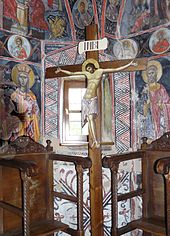 |
|
Good Friday cross from the Catholicon at Holy Trinity Monastery, Meteora,
Greece |
The first of these twelve readings John 13:31–18:1 is the longest Gospel reading of the liturgical
year, and is a concatenation from all four Gospels. Just before the sixth Gospel reading, which
recounts Jesus being nailed to the cross, a large cross is carried out of the sanctuary by the
priest, accompanied by incense and candles, and is placed in the center of the nave (where the
congregation gathers)
Semeron Krematai Epí Xýlou:
Today He who hung the earth upon the waters is hung upon the Cross (three times).
He who is King of the angels is arrayed in a crown of thorns.
He who wraps the Heavens in clouds is wrapped in the purple of mockery.
He who in Jordan set Adam free receives blows upon His face.
The Bridegroom of the Church is transfixed with nails.
The Son of the Virgin is pierced with a spear.
We venerate Thy Passion, O Christ (three times).
Show us also Thy glorious Resurrection.
The readings are:
- John 13:31–18:1 – Christ's last sermon, Jesus prays for the apostles.
- John 18:1–28 – The agony in the garden, the mockery and denial of Christ.
- Matthew 26:57–75 – The mockery of Christ, Peter denies Christ.
- John 18:28–19:16 – Pilate questions Jesus; Jesus is condemned; Jesus is mocked by the Romans.
- Matthew 27:3–32 – Judas commits suicide; Jesus is condemned; Jesus mocked by the Romans; Simon
of Cyrene compelled to carry the cross.
- Mark 15:16–32 – Jesus dies.
- Matthew 27:33–54 – Jesus dies.
- Luke 23:32–49 – Jesus dies.
- John 19:25–37 – Jesus dies.
- Mark 15:43–47 – Joseph of Arimathea buries Christ.
- John 19:38–42 – Joseph of Arimathea buries Christ.
- Matthew 27:62–66 – The Jews set a guard.
During the service, all come forward to kiss the feet of Christ on the cross. After the Canon, a
brief, moving hymn, The Wise Thief is chanted by singers who stand at the foot of the cross in the
center of the nave. The service does not end with the First Hour, as usual, but with a special
dismissal by the priest:
May Christ our true God, Who for the salvation of the world endured spitting, and scourging, and
buffeting, and the Cross, and death, through the intercessions of His most pure Mother, of our holy
and God-bearing fathers, and of all the saints, have mercy on us and save us, for He is good and
the Lover of mankind.
Royal Hours
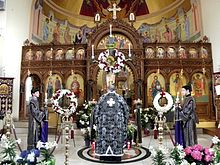 |
|
Vigil during the Service of the Royal Hours.
|
The next day, in the forenoon on Friday, all gather again to pray the Royal Hours, a special
expanded celebration of the Little Hours (including the First Hour, Third Hour, Sixth Hour, Ninth
Hour and Typica) with the addition of scripture readings (Old Testament, Epistle and Gospel) and
hymns about the Crucifixion at each of the Hours (some of the material from the previous night is
repeated). This is somewhat more festive in character, and derives its name of "Royal" from both
the fact that the Hours are served with more solemnity than normal, commemorating Christ the King
who humbled himself for the salvation of mankind, and also from the fact that this service was in
the past attended by the Emperor and his court.
Vespers of Holy and Great Friday
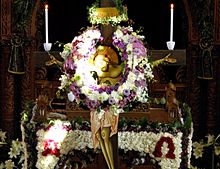 |
|
The crucified Christ, just before the Deposition from the Cross and the placing of the Epitaphios
in the Sepulcher.
|
In the afternoon, around 3 pm, all gather for the Vespers of the Taking-Down from the Cross,
commemorating the Deposition from the Cross. The Gospel reading is a concatenation taken from all
four of the Gospels. During the service, the body of Christ (the soma) is removed from the cross,
as the words in the Gospel reading mention Joseph of Arimathea, wrapped in a linen shroud, and
taken to the altar in the sanctuary.
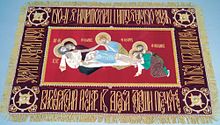 |
|
The epitaphios ("winding sheet"), depicting the preparation of the body of Jesus for burial
|
Near the end of the service an epitaphios or "winding sheet" (a cloth embroidered with the image
of Christ prepared for burial) is carried in procession to a low table in the nave which represents
the Tomb of Christ; it is often decorated with an abundance of flowers. The epitaphios itself
represents the body of Jesus wrapped in a burial shroud, and is a roughly full-size cloth icon of
the body of Christ. Then the priest may deliver a homily and everyone comes forward to venerate the
epitaphios. In the Slavic practice, at the end of Vespers, Compline is immediately served,
featuring a special Canon of the Crucifixion of our Lord and the Lamentation of the Most Holy
Theotokos by Symeon the Logothete.
Matins of Holy and Great Saturday
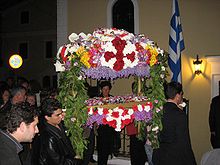 |
|
The Epitaphios being carried in procession in a church in Greece.
|
On Friday night, the Matins of Holy and Great Saturday, a unique service known as
The
Lamentation at the Tomb (
Epitáphios Threnos) is celebrated. This service is also
sometimes called
Jerusalem Matins. Much of the service takes place around the tomb of Christ
in the center of the nave.
A unique feature of the service is the chanting of the Lamentations or Praises (
Enkomia),
which consist of verses chanted by the clergy interspersed between the verses of Psalm 119 (which
is, by far, the longest psalm in the Bible). The
Enkomia are the best-loved hymns of
Byzantine hymnography, both their poetry and their music being uniquely suited to each other and to
the spirit of the day. They consist of 185 tercet antiphons arranged in three parts (
stáseis
or "stops"), which are interjected with the verses of Psalm 119, and nine short
doxastiká
("Gloriae") and
Theotókia (invocations to the Virgin Mary). The three
stáseis are
each set to its own music, and are commonly known by their initial antiphons: "Life in a grave",
"Worthy it is", and "All the generations". Musically they can be classified as strophic, with 75,
62, and 48 tercet stanzas each, respectively. The climax of the
Enkomia comes during the
third
stásis, with the antiphon "
O glyký mou Éar", a lamentation of the Virgin for
her dead Child ("O, my sweet spring, my sweetest child, where has your beauty gone?"). The
author(s) and date of the
Enkomia are unknown. Their High Attic linguistic style suggests a
dating around the 6th century, possibly before the time of St. Romanos the Melodist.
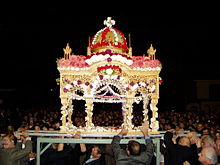 |
|
The Epitaphios mounted upon return of procession, at an Orthodox Church in Adelaide, Australia.
|
At the end of the Great Doxology, while the Trisagion is sung, the epitaphios is taken in
procession around the outside the church, and is then returned to the tomb. Some churches observe
the practice of holding the epitaphios at the door, above waist level, so the faithful most bow
down under it as they come back into the church, symbolizing their entering into the death and
resurrection of Christ. The epitaphios will lay in the tomb until the Paschal Service early Sunday
morning. In some churches, the epitaphios is never left alone, but is accompanied 24 hours a day by
a reader chanting from the Psalter.
The
Troparion (hymn of the day) of Good Friday is:
The noble Joseph, when he had taken down Thy most pure Body from the tree, wrapped it in fine
linen, and anointed it with spices, and placed it in a new tomb.
Glory to the Father, and to the Son, and to the Holy Spirit, both now and ever, and unto ages of
ages. Amen.
The angel came to the myrrh-bearing women at the tomb and said:
Myrrh is fitting for the dead, but Christ has shown Himself a stranger to corruption.
Western Apostolic Christianity
Day of Fasting
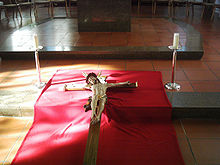 |
|
Crucifix prepared for veneration
|
The Catholic Church regards Good Friday and Holy Saturday as the Paschal fast, in accord with
Article 110 of Sacrosanctum Concilium. In the Latin Church, a fast day is understood as having only
one full meal and two collations (a smaller repast, the two of which together do not equal the one
full meal) – although this may be observed less stringently on Holy Saturday than on Good Friday.
Services on the day
The
Roman Rite has no celebration of Mass between the Lord's Supper on Holy Thursday
evening and the Easter Vigil unless a special exemption is granted for rare solemn or grave
occasions by the Vatican or the local bishop. The only sacraments celebrated during this time are
Baptism (for those in danger of death), Penance, and Anointing of the Sick. While there is no
celebration of the Eucharist, it is distributed to the faithful only in the Service of the Passion
of the Lord, but can also be taken at any hour to the sick who are unable to attend this service.
After the Lord's Supper any candlesticks and altar cloths, cross or crosses are removed leaving it
bare so that they may be returned in-ceremony on Easter Sunday which memorialises the day of
Christ's resurrection. It is also customary to empty the holy water fonts in preparation of the
blessing of the water at the Easter Vigil. Traditionally, no bells are rung on Good Friday or Holy
Saturday until the Easter Vigil.
The Celebration of the Passion of the Lord takes place in the afternoon, ideally at three o'clock;
however, for pastoral reasons (especially in countries where Good Friday is not a public holiday),
it is permissible to celebrate the liturgy earlier, even shortly after midday, or at a later hour
up until 9pm.
The vestments used are red (more commonly) or black (more traditionally). Before 1970, vestments
were black except for the Communion part of the rite when violet was used. Before the reforms of
the Holy Week Liturgies in 1955, black was used throughout. Before the 1955 Holy Week Reforms, Holy
Communion was not distributed to the faithful on Good Friday. If a bishop or abbot celebrates, he
wears a plain mitre (
mitra simplex).
Three Hours' Agony
The Three Hours' Devotion based on the
Seven Last Words from the Cross begins at noon and
ends at 3 pm, the time that the Christian tradition teaches that Jesus died on the cross.
Liturgy
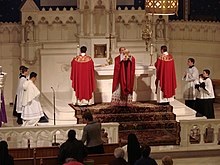 |
|
Communion from the Blessed Sacrament on Good Friday (Our Lady of Lourdes, Philadelphia)
|
The Good Friday liturgy consists of three parts: the Liturgy of the Word, the Veneration of the
Cross, and Holy Communion.
- The Liturgy of the Word consists of the clergy and assisting ministers entering in
complete silence, without any singing. They then silently make a full prostration. This signifies
the abasement (the fall) of (earthly) humans. It also symbolizes the grief and sorrow of the
Church. Then follows the Collect prayer, and the reading or chanting of Isaiah 52:13–53:12, Hebrews
4:14–16, 5:7–9, and the Passion account from the Gospel of John, traditionally divided between
three deacons, yet usually divided between the celebrant, one or two singers or readers, and the
congregation which speaks the part of the "crowd". In the older form of the Mass known as the
Tridentine Mass the readings for Good Friday are taken from Exodus 12:1–11 and the Gospel according
to St. John 18:1–40; 19:1–42.
- The Great Intercessions also known as orationes sollemnes immediately follows the
Liturgy of the Word and consists of a series of prayers for the Church, the Pope, the clergy and
laity of the Church, those preparing for baptism, the unity of Christians, the Jewish people, those
who do not believe in Christ, those who do not believe in God, those in public office, and those in
special need. After each prayer intention, the deacon calls the faithful to kneel for a short
period of private prayer; the celebrant then sums up the prayer intention with a Collect-style
prayer. As part of the pre-1955 Holy Week Liturgy, the kneeling was omitted only for the prayer for
the Jews.
- The Adoration of the Cross has a crucifix, not necessarily the one that is normally on
or near the altar at other times of the year, solemnly unveiled and displayed to the congregation,
and then venerated by them, individually if possible and usually by kissing the wood of the cross,
while hymns and the Improperia ("Reproaches") with the Trisagion hymn are chanted.
- Holy Communion is done according to a rite based on that of the final part of Mass,
beginning with the Our Father, but omitting the ceremony of "Breaking of the Bread" and its related
chant, the "Agnus Dei". The Eucharist, consecrated at the Evening Mass of the Lord's Supper on Holy
Thursday, is distributed at this service. Before the Holy Week reforms of Pope Pius XII in 1955,
only the priest received Communion in the framework of what was called the "Mass of the
Presanctified", which included the usual Offertory prayers, with the placing of wine in the
chalice, but which omitted the Canon of the Mass. The priest and people then depart in silence, and
the altar cloth is removed, leaving the altar bare except for the crucifix and two or four
candlesticks.
Stations of the Cross
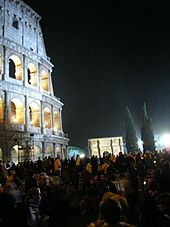 |
|
The Way of the Cross, celebrated at the Colosseum in Rome on Good Friday
|
In addition to the prescribed liturgical service, the Stations of the Cross are often prayed
either in the church or outside, and a prayer service may be held from midday to 3.00 pm, known as
the
Three Hours' Agony. In countries such as Malta, Italy, Philippines, Puerto Rico and
Spain, processions with statues representing the Passion of Christ are held.
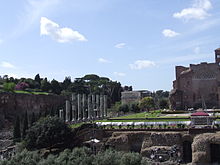 |
|
Rome: canopy erected at the "Temple of Venus and Rome" during the "Way of the Cross" ceremony
|
In Rome, since the papacy of John Paul II, the heights of the Temple of Venus and Roma and their
position opposite the main entrance to the Colosseum have been used to good effect as a public
address platform. This may be seen in the photograph below where a red canopy has been erected to
shelter the Pope as well as an illuminated cross, on the occasion of the
Way of the Cross
ceremony. The Pope, either personally or through a representative, leads the faithful through
meditations on the stations of the cross while a cross is carried from there to the Colosseum.
In Polish churches, a tableau of Christ's Tomb is unveiled in the sanctuary. Many of the faithful
spend long hours into the night grieving at the Tomb, where it is customary to kiss the wounds on
the Lord's body. A life-size figure of Jesus lying in his tomb is widely visited by the faithful,
especially on Holy Saturday. The tableaux may include flowers, candles, figures of angels standing
watch, and the three crosses atop Mt Calvary, and much more. Each parish strives to come up with
the most artistically and religiously evocative arrangement in which the Blessed Sacrament, draped
in a filmy veil, is prominently displayed.
Acts of Reparation to Jesus Christ
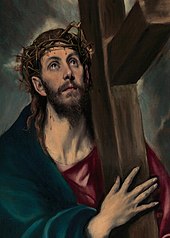 |
|
El Greco's Jesus Carrying the Cross, 1580
|
The Roman Catholic tradition includes specific prayers and devotions as
acts of reparation
for the sufferings and insults that Jesus suffered during his Passion on
Good Friday. These
Acts of Reparation to Jesus Christ do not involve a petition for a beneficiary, but aim to "repair
the sins" against Jesus. Some such prayers are provided in the
Raccolta Catholic prayer book
(approved by a Decree of 1854, and published by the Holy See in 1898) which also includes prayers
as Acts of Reparation to the Virgin Mary.
In his encyclical
Miserentissimus Redemptor on reparations, Pope Pius XI called Acts of
Reparation to Jesus Christ a duty for Catholics and referred to them as "some sort of compensation
to be rendered for the injury" with respect to the sufferings of Jesus.
Pope John Paul II referred to Acts of Reparation as the "unceasing effort to stand beside the
endless crosses on which the Son of God continues to be crucified".
Novena to the Divine Mercy
The Novena to the Divine Mercy begins on that day and lasts until the Saturday before the Feast of
Mercy. Both holidays are strictly connected, as the mercy of God flows from the Heart of Jesus that
was pierced on the Cross.
Protestant Christianity
Anglican Communion
The
1662 Book of Common Prayer did not specify a particular rite to be observed on Good
Friday but local custom came to mandate an assortment of services, including the
Seven Last
Words from the Cross and a three-hour service consisting of Matins, Ante-communion (using the
Reserved Sacrament in high church parishes) and Evensong. In recent times, revised editions of the
Prayer Book and Common Worship have re-introduced pre-Reformation forms of observance of Good
Friday corresponding to those in today's Roman Catholic Church, with special nods to the rites that
had been observed in the Church of England prior to the Henrican, Edwardian and Elizabethan
reforms, including Creeping to the Cross.
Lutheran Church
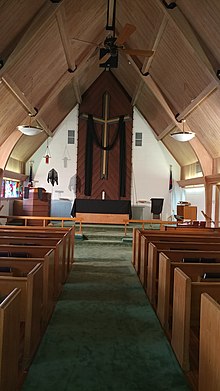 |
|
The chancel of this Lutheran church is adorned with black paraments on Good Friday, the liturgical
colour associated with Good Friday in the Lutheran Churches.
|
In Lutheran tradition from the 16th to the 20th century, Good Friday was the most important
religious holiday, and abstention from all worldly works was expected. During that time,
Lutheranism had no restrictions on the celebration of the Eucharist on Good Friday; on the
contrary, it was a prime day on which to receive the Eucharist, and services were often accentuated
by special music such as the
St Matthew Passion by Johann Sebastian Bach.
More recently, Lutheran liturgical practice has recaptured Good Friday as part of the larger sweep
of the great Three Days: Maundy Thursday, Good Friday, and the Vigil of Easter. The Three Days
remain one liturgy which celebrates the death and resurrection of Jesus. As part of the liturgy of
the Three Days, Lutherans generally fast from the Eucharist on Good Friday. Rather, it is
celebrated in remembrance of the Last Supper on Maundy Thursday and at the Vigil of Easter. One
practice among Lutheran churches is to celebrate a tenebrae service on Good Friday, typically
conducted in candlelight and consisting of a collection of passion accounts from the four gospels.
While being called "Tenebrae" it holds little resemblance to the now-suppressed Catholic monastic
rite of the same name. The Good Friday liturgy appointed in
Evangelical Lutheran Worship,
the worship book of the Evangelical Lutheran Church in America, specifies a liturgy similar to the
revised Roman Catholic liturgy. A rite for adoration of the crucified Christ includes the optional
singing of the Solemn Reproaches in an updated and revised translation which eliminates some of the
anti-Jewish overtones in previous versions. Many Lutheran churches have Good Friday services, such
as the Three Hours' Agony centered on the remembrance of the "Seven Last Words," sayings of Jesus
assembled from the four gospels, while others hold a liturgy that places an emphasis on the triumph
of the cross, and a singular biblical account of the Passion narrative from the Gospel of John.
Along with observing a general Lenten fast, many Lutherans emphasize the importance of Good Friday
as a day of fasting within the kalendar. A
Handbook for the Discipline of Lent recommends
the Lutheran guideline to "Fast on Ash Wednesday and Good Friday with only one simple meal during
the day, usually without meat".
Methodist Church
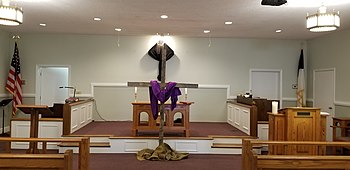 |
|
On Maundy Thursday, the altar of this Methodist church was stripped and the crucifix of this
Methodist church has been veiled in black for Good Friday (black is the liturgical colour for Good
Friday in the United Methodist Church). A wooden cross sits in front of the bare chancel for the
veneration of the cross ceremony, which occurs during the United Methodist Good Friday liturgy.
|
 |
|
A United Methodist minister prostrates at the start of the Good Friday liturgy at Holy Family
Church, in accordance with the rubrics in the Book of Worship. |
Many Methodist denominations commemorate Good Friday with fasting, as well as a service of worship
based on the Seven Last Words from the Cross; this liturgy is known as the Three Hours Devotion as
it starts at noon and concludes at 3 pm, the latter being the time that Jesus died on the cross.
Moravian Church
Moravians hold a Lovefeast on Good Friday as they receive Holy Communion on Maundy Thursday.
Communicants of the Moravian Church practice the Good Friday tradition of cleaning gravestones in
Moravian cemeteries.
Reformed Churches
In the Reformed tradition, Good Friday is one of the evangelical feasts and is thus widely
observed with church services, which feature the Solemn Reproaches in the pattern of Psalm 78,
towards the end of the liturgy.
Other Christian traditions
It is not uncommon for some communities to hold interdenominational services on Good Friday.
Associated customs
 |
|
Good Friday service in Ireland
|
In many countries with a strong Christian tradition such as Australia, Bermuda, Brazil, Canada,
the countries of the Caribbean, Chile, Colombia, Costa Rica, Czech Republic, Ecuador, Finland,
Germany, Hungary, Malta, Mexico, New Zealand, Peru, the Philippines, Portugal, the Scandinavian
countries, Singapore, Spain, Switzerland, the United Kingdom, and Venezuela, the day is observed as
a public or federal holiday.
In the United States, 12 states observe Good Friday as state holiday: Connecticut, Texas,
Delaware, Hawaii, Indiana, Tennessee, Florida, Kentucky, Louisiana, New Jersey, North Carolina and
North Dakota.
One associated custom is strict adherence to the Black Fast to 3pm or 6pm, where only water can be
consumed or restricted handout of bread, herbs and salt. St. Ambrose, St. Chrysostom and St. Basil
attest to the practice. The processions of the day, hymns "
Crux fidelis" by King John of
Portugal, and Eberlin's "
Tenebrae factae sunt", followed by "
Vexilla Regis" is sung,
translated from Latin as the standards of the King advance, and then follows a ceremony that is not
a real Mass, it is called the "Mass of the Pre-Sanctified.". This custom is respected also by
forgoing the Mass, this is to take heed to the solemnity of the Sacrifice of Calvary. This is where
the host of the prior day is placed at the altar, incensed, elevated so "that it may be seen by the
people" and consumed. Germany and some other countries have laws prohibiting certain acts, such as
dancing and horse racing, that are seen as profaning the solemn nature of the day.
Australia and New Zealand
Good Friday is a holiday under state and territory laws in all states and territories in
Australia. Generally speaking, shops in all Australian states (but not in the two territories of
the Northern Territory and the Australian Capital Territory) are required to remain closed for the
duration of Good Friday, although there are certain shops which are permitted to open and other
shops can apply for exemptions. All schools and universities close on Good Friday in Australia, and
Good Friday falls within the school holidays in most years in all states and territories except the
Northern Territory, although many states now commence their school holidays in early April
regardless of Easter. In 2018, for example, when Good Friday fell on 30 March, only Queensland and
Victoria had school holidays which coincided with Good Friday. The vast majority of businesses are
closed on Good Friday, although many recreational businesses, such as the
Sydney Royal Easter
Show, open on Good Friday as among non-religious families Good Friday is a popular day to
indulge in such activities. In New Zealand, Good Friday is a legal holiday and is a day of
mandatory school closure for all New Zealand state and integrated schools. Good Friday is also a
restricted trading day in New Zealand, which means that unexempted shops are not permitted to open
on this day.
Canada
.jpg) |
|
Vespers of Good Friday afternoon, Greek Orthodox Cathedral in Toronto
|
In Canada, Good Friday is a federal statutory holiday. In the province of Quebec "employers can
choose to give the day off either on Good Friday or Easter Monday."
Cuba
In an online article posted on Catholic News Agency by Alejandro Bermúdez on 31 March 2012, Cuban
President Raúl Castro, with the Communist Party and his advisers, decreed that Good Friday that
year would be a holiday. This was Castro's response to a request made personally to him by Pope
Benedict XVI during the latter's Apostolic Visitation to the island and León, Mexico that month.
The move followed the pattern of small advances in Cuba's relations with the Vatican, mirroring
Pope John Paul II's success in getting Fidel Castro to declare Christmas Day a holiday. Both Good
Friday and Christmas are now annual holidays in Cuba.
Ireland
In the Republic of Ireland, Good Friday is not an official public holiday, but most non-retail
businesses close for the day. Up until 2018 it was illegal to sell alcoholic beverages on Good
Friday, with some exceptions, so pubs and off-licences generally closed. Critics of the ban
included the catering and tourism sector, but surveys showed that the general public were divided
on the issue. In Northern Ireland, a similar ban operates until 5 pm on Good Friday.
Philippines
In the predominantly Roman Catholic Philippines, the day is commemorated with street processions,
the
Way of the Cross, the chanting of the
Pasyón, and performances of the
Senákulo or
Passion play. Some devotees engage in self-flagellation and even have
themselves crucified as expressions of penance despite health risks and strong disapproval from the
Church.
Church bells are not rung and Masses are not celebrated, while television features movies,
documentaries and other shows focused on the religious event and other topics related to the
Catholic faith, broadcasting mostly religious content. Malls and shops are generally closed, as are
restaurants as it is the second of three public holidays within the week.
After three o'clock in the afternoon (the time at which Jesus is traditionally believed to have
died), the faithful venerate the cross in the local church and follow the procession of the Burial
of Jesus.
In Cebu and many parts of the Visayan Islands, people usually eat
binignit and
biko
as a form of fasting
United Kingdom
 |
|
Hot cross buns are traditionally toasted and eaten on Good Friday in Britain, Canada and Australia.
|
In the UK, Good Friday was historically a common law holiday and is recognised as an official
public holiday (also known as a Bank Holiday). All state schools are closed and most businesses
treat it as a holiday for staff; however, many retail stores now remain open. Government services
in Northern Ireland operate as normal on Good Friday, substituting
Easter Tuesday for the
holiday.
There has traditionally been no horse racing on Good Friday in the UK. However, in 2008, betting
shops and stores opened for the first time on this day and in 2014 Lingfield Park and Musselburgh
staged the UK's first Good Friday race meetings. The BBC has for many years introduced its 7 am
News broadcast on Radio 4 on Good Friday with a verse from Isaac Watts' hymn "
When I Survey the
Wondrous Cross".
United States
In the United States, Good Friday is not a government holiday at the federal level; however,
individual states, counties and municipalities may observe the holiday. Good Friday is a state
holiday in Connecticut, Delaware, Florida, Hawaii, Indiana, Kentucky (half-day), Louisiana, New
Jersey, North Carolina, North Dakota, Tennessee and Texas. State and local government offices and
courts are closed, as well as some banks and post offices in these states, and in those counties
and municipalities where Good Friday is observed as a holiday. Good Friday is also a holiday in the
U.S. territories of Guam, U.S. Virgin Islands and Puerto Rico.
The stock markets are closed on Good Friday, but the foreign exchange and bond trading markets
open for a partial business day. Most retail stores remain open, while some of them may close
early. Public schools and universities are often closed on Good Friday, either as a holiday of its
own, or as part of spring break. The postal service operates, and banks regulated by the federal
government do not close for Good Friday.
In some governmental contexts Good Friday has been referred to by a generic name such as
"
spring holiday". In 1999, in the case of
Bridenbaugh v. O'Bannon, an Indiana state
employee sued the governor for giving state employees Good Friday as a day off. The US Seventh
Circuit Court of Appeals ruled against the plaintiff, stating that the government could give state
employees a paid day off when that day is a religious holiday, including Good Friday, but only so
long as the state can provide a valid secular purpose that coincides with the obvious religious
purpose of the holiday.
Criticism from non-observers
Some Baptist congregations, the Philadelphia Church of God, and some non-denominational churches
oppose the observance of Good Friday, regarding it as a papist tradition, and instead observe the
Crucifixion of Jesus on Wednesday to coincide with the Jewish sacrifice of the Passover Lamb (which
some/many Christians believe is an Old Testament pointer to Jesus Christ). A Wednesday Crucifixion
of Jesus allows for him to be in the tomb ("heart of the earth") for three days and three nights as
he told the Pharisees he would be (Matthew 12:40), rather than two nights and a day (by inclusive
counting, as was the norm at that time) if he had died on a Friday. Preparation Day (14 Nisan on
the Hebrew calendar) – which is the day before Passover (15 Nisan), instead of the Friday morning
as the Synoptic Gospels refer to the sabbath and they believe this refers to a "high sabbath" which
occurs on feast days, and not the ordinary weekly sabbath.


.jpg)















.jpg)
